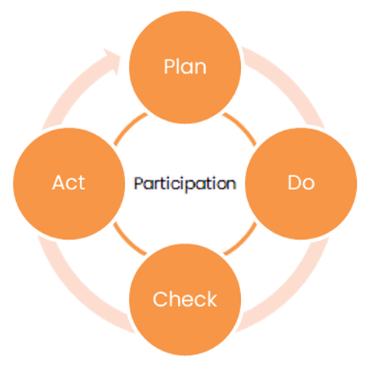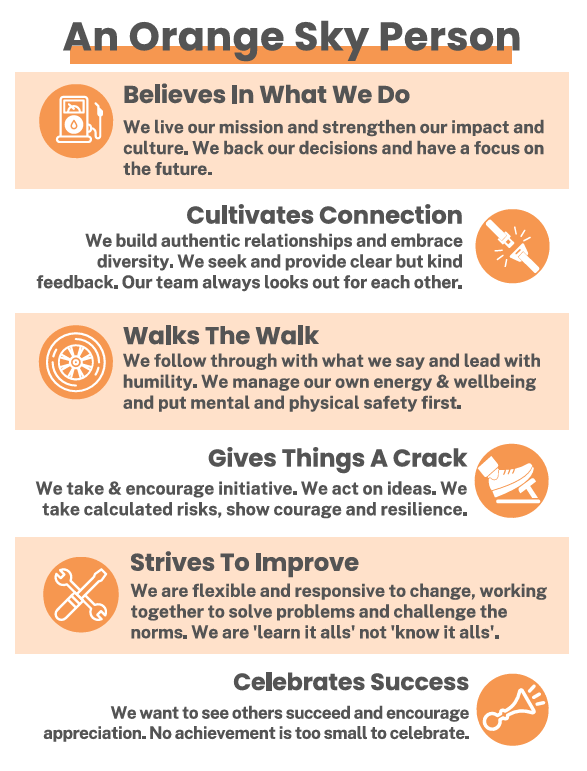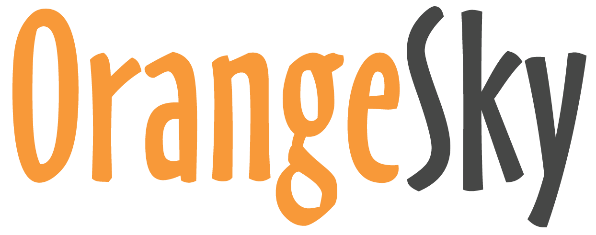(Issue Date 18/07/2024)
Scope
This framework applies to all OS employees, visitors, contractors and volunteers engaging in activities with OS.
WHS Management System Framework
This document outlines the Orange Sky (OS) WHS Management System that is in place to help meet Orange Sky’s commitment to workplace health and safety.
The WHS management system is a collection of policies, procedures and plans to systematically ensure and improve the health and safety of people at OS (Figure 1). Where possible WHS instructions and processes are incorporated into standard business activities to reinforce that safety is part of everyday work and reduce the burden on workers. An integrated approach considers work safety and injury prevention with health and wellbeing to enhance worker health and prevent work related injuries and illness (physical and psychological). OS recognises the general physical and psychological health of a workforce has a direct impact on work health, safety and wellbeing outcomes.
The framework has been prepared considering AS/NZS ISO 45001: Occupational health and safety management systems – Requirements with guidance and use as a guide. No attempt has been made to align fully or seek certification with the standard. Continuous improvement is at the core of WHS management and this framework adopts the Plan-Do-Check-Act methodology.
The internal Orange Sky People & Safety team are responsible for developing and regularly reviewing the WHSMS Framework and supporting documents. When documents and processes are owned by areas outside of the People & Safety team these areas are responsible for consulting with the People & Safety team to ensure that WHS requirements are met.
Figure 1:

This policy and associated WHSMS documentation are available in electronic format within OS’s resource portal. Modifications to this policy are made periodically to ensure it is current.
WHS Policy
The WHS policy outlines OS’ commitment to the physical and psychological safety and wellbeing of workers, contractors, visitors and friends. The policy aligns this commitment with the mission, values and culture of the organisation.
Leadership, participation and consultation
OS demonstrates a commitment to WHS leadership, participation and consultation through clear roles and responsibilities, performance management processes and robust communication and consultation.
Participation
OS requires workers to participate in health and safety management to establish and maintain a positive safety culture and workplace wellbeing. This is facilitated through team, senior leadership and board meetings and at a worker level with the inclusion of shift reports, communications and training initiatives. Participation is supported through clear procedures, induction and training with safety participation part of normal work.
Plan
WHS Planning
Opportunities for improvement are prioritised based upon risk, frequency and severity. The annual WHS improvement plan is developed utilising risks identified through data analysis and review and from the OS Enterprise Risk Register. Business continuity plans are in place to prepare for and respond to emergency situations.
Legislative Requirements
Legislative requirements are monitored by respective areas and modifications completed as required (see Legislation Compliance Register).
Risk Management
Work related issues (including psychosocial hazards) are identified and reported through checks, incident notifications, workers compensation claims, employee surveys, HR data and feedback from workers, managers and executives. WHS risk management is undertaken as per the OS Risk Management Framework. Training is provided to workers in how to identify hazards, manage risk and implement controls..
Do
Responsibility and Accountability
Responsibility and accountability is allocated for the WHSMS and its components. Roles and responsibilities are specified in individual position descriptions, work procedures as well as within individual elements of the WHSMS.
Training
Mandatory training and induction is in place for all OS workers (employees, volunteers and contractors). Targeted instruction is provided to all workers both online or as part of their commencement shifts.
Contractor and Visitor Management
All work is completed by contractors with the appropriate level of skills and knowledge to perform the required tasks. Required licences, training or safe work instruction must be provided to OS prior to starting work.
Communication and Consultation
Communication and consultation occurs directly with workers through a variety of business wide systems (e.g. Slack, ASANA, WhatsApp, Volunteer Management System) that are accessible using computers and smartphones (OS and personal devices). Shift reports are completed for all shifts.
Communication with volunteers is primarily managed by the Operations team. Communication processes with contractors should be discussed and agreed upon during engagement.
Rehabilitation & Return To Work
Rehabilitation and Return to Work processes and resources are in place to support the safe and timely return to work for injured or ill employees. These processes are utilised to support employees with work and non-work injuries and illness alike. Processes are also in place for volunteers.
Emergency Management
All workers are provided with emergency response training/instruction. This can cover fire, medical emergencies, security threats, safety threats and extreme weather. Emergency drills are completed at OS HQ and Risk Management plans for each shift location..
Risk Controls
Procedures, guides, operating procedures and templates are provided to equip workers in managing identified risks, including but not limited to vehicle, occupational violence, chemical, manual tasks, infection and electrical.
Check
Inspection and Audit
A regular program of WHS verification activities is in place and in review which will assist with the identification of WHS improvement opportunities. Audits also direct allocation of resources and support due diligence. External audits and inspections are completed in some instances as required.
Incident and Action Management
The incident reporting system (using Volunteer Management System and ASANA) supports incident collation, review, investigation and response as well as short and long term trend analysis. The triaging, consultation and resolution of incidents is managed by a core group of OS workers who frequently discuss opportunities and risks associated with incidents.
Reporting
A variety of safety metrics, opportunities, actions and improvements are reported to support due diligence by the OS Executive and Board and inform employees. Reports are tailored to the audience and generated monthly for review and discussion.
Act
Due Diligence
Due diligence is demonstrated through the review and planning activities of the Executive team and the Board (and committees).
Continual Improvement
Continual improvement activities are completed from reviews, audits, inspections and incident reports. Actions are incorporated into the WHS Improvement Action Plan (see below table), other plans and budgets as appropriate. [] indicates items in draft
WHS POLICY | ||
PLAN | WHS Planning | WHS Policy Framework (NAME VARIES IN EXISTING DOCS) WHS Improvement Action Plan (Safety Improvement Project, Asana) ASANA |
Legislative Requirements | Legislation (QLD, NSW, VIC, SA, WA, NT, ACT, TAS, NZ) Codes of Practice Standards (guidance only) | |
Risk Management | Risk Management Framework Risk Management Procedure - DRAFT Enterprise Risk Register ASANA Airtable (Shift Risk Assessments) | |
DO | Responsibility and Accountability | Position descriptions and organisational structure (employees and volunteers) Emergency Management Team (HQ) |
Training | Mandatory Induction (Volunteer, Employee) OSA Emergency Warden Training (Lite) Emergency evac practice | |
Contractor and Visitor Management | ||
Communication and Consultation | Work Health and Safety Policy Framework Slack Staff meetings ASANA (People and Other Incidents Project) | |
Wellbeing and RRTW | Rehabilitation & Return to Work Policy Employee & Volunteer Assistance Programs run by 3rd party provider | |
Emergency Management | Emergency Plans Business Continuity Plan | |
Risk Controls | Existing Documentation PROCEDURES Asset Repair Procedure Inclement Weather Procedure GUIDES Safe Word Safe Place Trigger Action Response Plan (TARP) Preventing Aggression on Shift Safe Manual Handling Inclement Weather Guide Safely Handling Sharps Safe Working in Heat Wearing Gloves on Shift Shower Safety Checklist Safe Showers at Orange Sky Out of Service Stickers Safe Viewing of a Van Driving an OS Van Safe Reversing Guide Completing Risk Assessments Community Recovery Support Guide HQ Lock up Guide Guide to Biohazard Cleaning of Machines Guide to Slips, Trips & Falls on Shift Guide to Working From Home Guide to Completing a Take 5 Guide to Pre/Post Shift Van Clean First Aid Kit Restock List Plugging into Power on Shift Volunteer Shift Safety Induction Guide to Responding to a Sharps Injury Guide to Out of Service Sticker Guide to Managing Scabies COVID-19 Golden Rules SWP Safe Set Up & Pack Down Sort Wash Dry Laundry Avoiding Slips Trip & Falls on Shift Cleaning up Bodily Fluids Washing Machine Biohazard Clean Dryer Biohazard Clean Shower Biohazard Clean Refilling Diesel Jerry Cans for Pods Setting Up 3x3 Gazebo Safe Washing of an OS Vehicle Removing Spare Tyre - Laundry Van Dalby Laundromat Gold Coins Safe Handling and Disposal of Sharps Precautionary Asset Clean SWP Plugging into Power on Shift Changing a Fuse CHECKLISTS Workstation Ergonomics Checklist (OSA-WW-HQ-WHS-CHK-001) [PLANNED SUPPORT MATERIAL STRUCTURE] Standards of Behaviour/Terms of Use Risk Management (principles, putting people first, reporting issues, sharing and finding solutions) Driving Shift setup/pack up Sun and weather safety Emergencies (TARP/Daphne, fires, medical, weather) Laundry work (loading/unloading, trips and slips, etc) Infection control (includes standard precautions, cleaning and biohazard response, chemicals) First Aid Personal interaction Injuries (physical and psychosocial) Incident reporting, investigation and actions On site breakdowns and repairs (user serviceable, out of service stickers) Diesel Workshop safety Screen-printing HQ Cleaning HQ Info (working from home, security, workshop info/precautions, cleaning, first aid, emergency, van parking) Some specific variations for remote & adjacent service offerings activities planned | |
CHECK | Inspection and Audit | Fire System Testing Workstation Ergonomics Checklist First Aid Checklist WHS verification activities (in development) Employee Surveys |
Incident and Action Management | Incident report, investigation and follow up (Volaby to ASANA) Incident Management Process (Volunteer Guide and Asana tasks, flow) | |
Reporting | Monthly Board Reporting Shift Reports (Volunteer Management System) | |
ACT | Due Diligence | Due Diligence activities by officers |
Requirements for Performance
A modern functional WHSMS will support mature WHS leadership across all levels of the business and integrate with other business processes. Key to this functionality is supporting people to look after their own safety and that of others. Key principles and performance requirements are considered in the review and improvement of WHSMS components to ensure that the system meets required goals.
Principles and performance requirements
Due diligence
As it applies to an officer (S27 of the WHS Act (AUS)/S44 of the WHS Act (NZ)) due diligence includes personally taking reasonable steps to:
acquire and keep up-to-date knowledge of work health and safety matters; and
gain an understanding of the nature of the operations of the business or undertaking and generally of the hazards and risks associated with those operations; and
ensure availability for use and actual use of appropriate resources and processes to eliminate or minimise risks to health and safety; and
ensure that there are appropriate processes for receiving and considering information regarding incidents, hazards and risks and responding in a timely way to that information; and
ensure there are, and they are implemented, processes for complying with any duty or obligation of the person conducting the business or undertaking under this Act; and
verify the provision and use of the resources and processes mentioned in paragraphs (c) to (e)
For paragraph (e), the duties or obligations under this Act of a person conducting a business or undertaking may include:
reporting notifiable incidents
consulting with workers
ensuring compliance with notices issued under this Act
ensuring the provision of training and instruction to workers about work health and safety
ensuring that health and safety representatives receive their entitlements to training.
Note: slight differences exist in the wording between jurisdictions, there are no material differences in the impact on OS.
Duty of care
Everyone has a duty of care, a responsibility, to make sure that they and other people are safe in the workplace. OS has a strong reliance on volunteers and contractors which along with employees are considered workers.
Duties of workers. While at work, a worker must:
take reasonable care for their own health and safety; and
take reasonable care that their acts or omissions do not adversely affect the health and safety of other persons; and
comply, so far as the worker is reasonably able, with any reasonable instruction that is given by the person conducting the business or undertaking to allow the person to comply with this Act; and
co-operate with any reasonable policy or procedure of the person conducting the business or undertaking relating to health or safety at the workplace that has been notified to workers.
Duties of other persons at the workplace. A person at a workplace, whether or not the person has another duty under this part, must:
take reasonable care for their own health and safety; and
take reasonable care that their acts or omissions do not adversely affect the health and safety of other persons; and
comply, so far as the person is reasonably able, with any reasonable instruction that is given by the person conducting the business or undertaking to allow the person conducting the business or undertaking to comply with this Act.
Safety II Approach
The community services sector is intrinsically unpredictable, additionally OS is a service provider where workers regularly encounter people doing it tough. In this environment workers need to be adaptable.
Traditional WHS (Safety-I) is rooted in factory line work, a routine and controlled situation. Things go wrong because of identifiable failures or malfunctions of specific components: technology, procedures, workers and the organisation in which they work. People are viewed as a liability or hazard because they are the most variable part of the system.
Safety-II switches approach towards ensuring that ‘as many things as possible go right’ under varying conditions (Table 1). People are seen as a resource necessary for system flexibility and resilience. Investigations focus on understanding how things usually go right, since that is the basis for explaining how things occasionally go wrong. Guiding principle is to facilitate everyday work, to anticipate developments and events, and to maintain the adaptive capacity to respond effectively to the inevitable surprises (Finkel 2011).
Cognitive Load
The OS WHSMS has been reviewed with consideration of the impacts of cognitive load on responses to health, safety and wellbeing issues which will be incorporated into any revisions. Cognitive load is the amount of information that working memory can hold at one time. To mitigate cognitive overload, instructional methods should aim to streamline information delivery, breaking down complex tasks into manageable steps and using clear, concise communication. This helps ensure that working memory is not overwhelmed, facilitating better decision-making, reduced stress, improved judgment, and overall job satisfaction.
OS Person Characteristics
The OS Person Characteristics guide our actions and behaviours. They describe the kind of people we want to work and interact with, and who we aspire to be. The WHS processes should support all workers to actively demonstrate these characteristics, fostering a culture of safety. By integrating these considerations into our WHS revisions, we can better support our team in embodying the OS Person Characteristics, leading to a safer and more positive workplace.

Definitions
Term | Description |
Consultation | Consultation is a collaborative process between the PCBU and workers. It involves sharing information about health and safety. |
Due diligence | A responsibility of the business to protect the health, safety and welfare of all workers and others who could be put at risk from work carried out in the course of business. |
Duty of care | A responsibility everyone has to keep themselves and other people safe in the workplace |
Officer | An officer is a person who makes, or participates in making, decisions that affect the whole, or a substantial part, of the organisation's activities. Officers are likely to include people such as board members, directors, CEO in some cases other senior managers (i.e. CFO, COO). |
PCBU | Person conducting a business or undertaking, e.g. Orange Sky |
Reasonably practicable | What can reasonably be done in the circumstances when complying with duties to ensure health and safety under legislation. |
RRTW | Rehabilitation and Return to Work. Includes workers compensation activities and recovery at work from injury. |
Wellbeing | Wellbeing at work can include:
|
WHS Management System | A collection of policies, procedures and plans to systematically ensure and improve the health and safety of people at OS. |
Worker | Any person who carries out work, including work as an employee, contractor, subcontractor, self-employed person, outworker, apprentice or trainee, work experience student, employee of a labour hire company placed with a 'host employer' and volunteers. |
